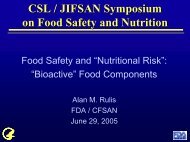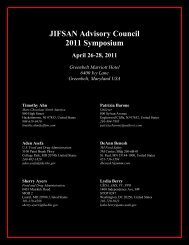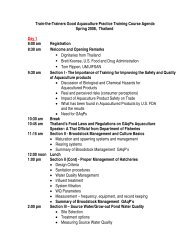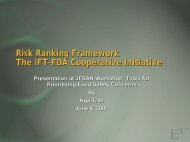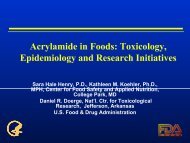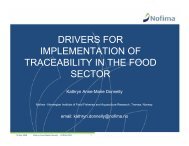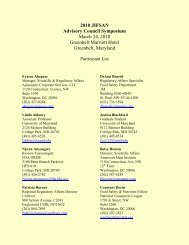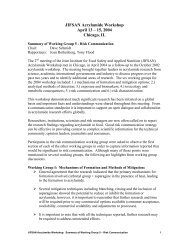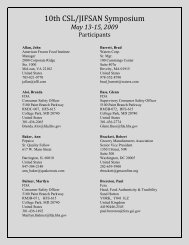PDF - jifsan
PDF - jifsan
PDF - jifsan
- No tags were found...
Create successful ePaper yourself
Turn your PDF publications into a flip-book with our unique Google optimized e-Paper software.
Joint Institute for FoodSafety and Applied NutritionInfluence of Pre-harvestAntibiotic Pesticide Treatment on theNative Microflora of Apple and Pear Blossoms,Leaves, Fruit, and Cider andits Implications for Food SafetyDr. Christopher S. Walsh
Collaborators• Arthur Miller, CFSAN• Brian Shawn Eblen, CFSAN• Andrea Ottesen, UMD• Doug Price, UMD Keedysville• JIFSAN undergraduate students
BackgroundLimited knowledge on relationship betweenunpasteurized apple cider safety and:Good agricultural practices•Known-Avoid drops (2 log safety improvement)-Use U.S. cider grade apples or better(
Unpasteurized Apple Cider as aPublic Health ProblemCider-Associated Outbreaks• 1974 Salmonella (300 cases)• 1980 E. coli O157:H7 (23 HUS cases)• 1993 Cryptosporidium (213 cases)• 1996 E. coli O157:H7 (3 outbreaks)Cryptosporidium(213 cases)• 1999 E. coli O157:H7• 2003 Cryptosporidium (>5 cases)• 2004 E. coli, Cryptosporidium, Camplobacter
Fire Blight (Erwinia amylovora)• Gram negative bacterial pathogen that attacksmembers of the Rosaceae• Major problem in apple and pear orchards• Lethal to many pear varieties• Lethal to popular apple rootstocks• Limits apple exports to Japan• Treatments: Copper, Streptomycin and Oxytetracycline• Streptomycin-resistant Erwinia epidemic in MI, 2001
Data Gaps:What is the effect of fireblight controls onmicrobial ecology in the orchard?Unknown : Influences of antibiotic use– Effect on overall orchard microflora– Effect on presence of Gram negative humanpathogens responsible for illness outbreaks– Organic pesticides ?
Does less pesticide reduce chemical risks butincrease biological risks?Plot 1: Unsprayed“Transitional Organic”Plot 3: ConventionalSpray Schedule
Experimental Design:Plot 1: Unsprayed“Transitionally organic”Plot 2: Early Sprays OnlyConventional sprays until June 15 th,Unsprayed July, Aug, Sept.Plot 3: Conventional Spray
Experimental Procedure:Duplicate sets of apples are collected from fourlocations on each tree in the three experimentalplots.“Wash” is prepared from surface microflora and20 ml of water and 0.1% peptone buffer pH 6.8Dilutions of the wash are plated onto generaland selective media.Populations are counted, recorded, andanalyzed statistically using SAS.
Preliminary Experiment (2002)Dependent Variables• Yeast and Molds, BHIA, MacConkey, TotalColiformsIndependent Variables• Pesticide Application• Tissue (Leaf, Fruit and Shoot)• Position within TreeSamples taken in August, Sept. and Oct.
Preliminary Results (2002)Significant Effects• Pesticide Usage(Half log reduction with Pesticide Usage)• Position within TreeNon-significant Effects• Leaf and Fruit Counts Similar• Shoot Counts Extremely Variable
Less-selective MediaBrain Heart Infusion Agar (BHIA)Total aerobic count3M Petri FilmYeasts and Molds
Selective mediaMacConkey(Gram negative bacteria)Petri Film Total Coliforms(30 - 37C)
Total Aerobic CountBHIA (2003) Log CFU / Apple (SE)Treatment Early-Season Late-SeasonFull Spray 4.38 (.06) 4.35 (.03)Half Spray 4.49 (.06) 4.39 (.02)No Spray 4.55 (.06) 4.59 (.03)
Selective Media for Gram Negative BacteriaMacConkey(2003) Log CFU / Apple (SE)Treatment Early-Season Late-SeasonFull Spray 3.30 (.03) 4.23 (.05)Half Spray 3.31 (.04) 4.57 (.05)No Spray 3.53 (.05) 4.81 (.05)
Selective Media 3M Petri FilmTotal Coliforms (2003) Log CFU / Apple (SE)Treatment Early-Season Late-SeasonFull Spray 1.93 (.03) 2.75 (.05)Half Spray 1.74 (.03) 3.06 (.05)No Spray 1.79 (.03) 3.27 (.05)
Laboratory ‘Cider’ (2003)Plate Counts Log CFU / cm 2Treatment BHIA MacConkey Total ColiFull Spray 2.4 1.6 1.3Half Spray 3.1 2.5 2.3No Spray 3.0 2.4 2.5
Discussion:•Is the log reduction a significant GAP?•How does it affect human pathogens?Option 1:Reduce risk by direct kill of human pathogens ?Option 2:Increase risk for human pathogen survival if nativemicroflora are no longer occupying competing niches ?
Organic Production and GAPs.To be profitable, organic orchards require ciderproduction.What are the implications on food safetycaused by the change from conventional toorganic production systems?
Wye Experimental Organic vs. IPM (Conventional) Orchard
AREAS OF RESEARCH INVESTIGATIONJIFSAN FUNDINGFood Safety IssuesFruit QualityAGROECOLOGY FUNDINGSpecialty Crop PotentialEconomicsInsecticide, Herbicide,Fungicide and FertilizationRequirements and Recommendations
ORGANIC VS. CONVENTIONAL PLOTSDesign:• Randomized orchardblocks: 2.5 acres• 50 feet betweenconventional and organicconditions – (MDA)• Organic Certificationanticipated in fall, 2005
NINE CULTIVARS3 Disease resistant apple cvLIBERTY, GOLDRUSH,ENTERPRISELIBERTYOLYMPICGALA3 Asian pear cvOLYMPIC, ATAGO,NITAKAENTERPRISENITAKAFUJI3 Commercial apple cvGALA, FUJI, CORTLANDGOLDRUSHATAGOCORTLAND
Pressure treated wood for tree supportin the conventional plots“Strips” prepared with herbicide,GramoxoneFertilized w/Calcium nitrateAluminum poles for tree supportIn the organic plotsDedicated “organic” product sprayersused for all applications.Mowers cleaned before use in organicplots.
PLANTING YEAR: PEARS PLANTED 4/17/03 APPLES PLANTED 4/20/03ORGANIC MATERIALS 2003 IPM ORCHARD MATERIALS 20034/30/03 Fertilize Nitro Mix6/6/03 Herbicide: All Down6/10/03 Herbicide: 20% acetic acid7/4/03 Insecticide: Pyganic7/7/03 Herbicide: All Down7/10/03 Fertilizer: Nitro Mix7/13/03 Pyganic & Sulfur7/25/03 Pyganic, Sulfur & Surround9/16/03 Pyganic, Sulfur & Surround3/24/03 Herbicide: Roundup4/30/03 Fertilize Ca(NO3)25/29/03 Herbicide: Gramoxone7/2/03 Herbicide: Roundup7/4/03 Imidan, Captan, Provado7/10/03 Calcium Nitrate7/17/03 Captec & Provado7/30/03 Captec, Sulfur, Imidan, Nova8/19/03 Captec, Sulfur, Imidan, Nova9/6/03 Captec, Provado, Topsin9/16/03 Roundup
ORGANIC MATERIALS 2004 CONVENTIONAL MATERIALS 20044/10/04 Pyganic, Sulfur, Surround4/20/04 Pyganic, Sulfur4/30/04 Sulfur5/5/04 Sulfur, Pyganic & Surround5/13/04 Sulfur, Pyganic & Surround5/24/04 Sulfur, Pyganic & Surround6/7/04 Pyganic, Sulfur, Surround,Entrust6/17/04 Pyganic, Sulfur, Surround,Entrust6/24/04 Fertilize McGeary 5-3-47/15/04 Pyganic, Sulfur, Surround,Entrust7/22/04 Pyganic, Sulfur, Surround,Entrustcont.4/10/04 Warrior, Dithane, Rubign4/20/04 Solican & Geamoxone4/30/04 Dithane & Topsin5/5/04 Mancozeb & Imidan5/13/04 Mancozeb, Imidan & Topsin6/7/04 Imidan, Thiodon, Captec,Topsin6/28/04 Imidan, Nova, Provado, Captec7/15/04 Imidan, Nova, Provado, Captec7/22/04 Imidan, Captec, Topsin, Vydate8/4/04 Roundup8/5/04 Imidan, Captec, Topsin,Thiodon8/20/04 Captec, Topsin & Sevin
ORGANICCONVENTIONALAUGUST 25 THHARVEST OF ATAGO PEARS-16 months after planting orchard.
Preliminary Greenhouse Study, 2004Purpose- To develop a protocol fortesting applications of coliform bacteriaunder controlled conditions.March. Plant 50 apple trees incontainer nursery in ‘soilless’ mix.June. FSIS clearance sought to useGFP and K12 strains under controlledconditions.
Preliminary Greenhouse Study, 2004July and August. Greenhousebackground/safety tests. Swab forcoliforms 4 separate occasions. Lowbackground level found in greenhouse.Log 2-log 3 levels in floor drains.August. Move container grown treesinto greenhouse and begin shootbioassays.
FACTORIAL STUDY OF K12 SURVIVALEFFECT OF ALUMINUM FOIL
Preliminary Greenhouse Study, 2004September. Controlled inoculations usingK12 suspended in solution with non-ionicsurfactant allow uniform wetting, andcontrolled treatments.A factorial testing incubation temperature(22 vs 37) and humidity demonstrated thataluminum foil covers over beakers held at22 C allowed recovery of inoculated K12for 7 to 10 days.
Research to be completed in early-2005•Compare counts in ‘cider’ made fromUnsprayed and Sprayed trees atKeedysville orchard•Compare bacterial counts in ‘cider’ madefrom organic and conventional apples andpears from Wye•Test the effects of organic pesticidessurvival of K12 and/or GFP ongreenhouse-grown shoots in thelaboratory





